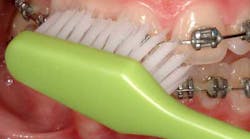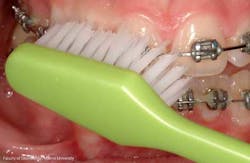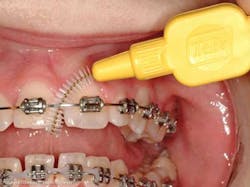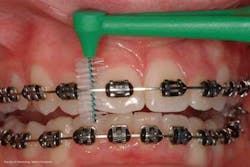Does your patient follow your home-care recommendations?
As a dental hygienist who works in private practice, a frequent challenge is a patient who has not followed through with my professional recommendations and is not motivated to take care of their oral cavity. I will share with you my methods for decreasing plaque and increasing patient motivation, supported with evidence-based information.
Additional reading | The role of the dental hygienist in orthodontics
Selecting the correct toothbrush
Selecting the right toothbrush for your patient is just as important as selecting the right size interdental brush. TePe Oral Health Care, Inc., offers a wide range of products, including toothbrushes, implant brushes, and interdental brushes designed to optimize oral health. TePe’s Supreme™ toothbrush is perfect for cleaning above and below the wire and around brackets of braces. Its innovative two-level filament design will effectively clean where plaque and food hide. The longer filaments will reach below the wire, around the brackets, and along the gingival margin. The shorter filaments gently clean the rest of the tooth surfaces. It has minimal plastic backing on the tapered brush head, allowing it to more easily fit into the buccal space.
Additional reading | Motivating teens to better oral care through the use of dental technology
Interdental brushes
In additional to regular brushing, an interdental brush (IDB) is the most effective way to remove dental plaque interproximally. (1-3) In a recent study comparing floss and IDBs, improved interproximal plaque reduction was shown in the IDB group (23 of 30 people). (2) Established oral biofilms, predominately gram-negative, cause and exacerbate gingival inflammation and can lead to demineralization and caries. (1,2,4) Removing or disrupting the biofilm is key. TePe has a range of nine color-coded brushes to fit different interdental spaces. TePe IDBs have plastic coated wires, diameters ranging from 0.4 mm to 1.5 mm, and are safe to use around the teeth, orthodontic brackets, and implants. The brushes are made in Sweden of the highest grade nylon filaments, as they have been since their development in the early 1990s.
Interdental cleaning. It has been well documented that compliance with dental flossing is low because it is challenging to use. (1,3)Patients who have good dexterity, motivation, and type I embrasures may do fine with floss. If these patients have poor dexterity and are not motivated to use floss, I recommend the smallest (pink) TePe IDB. Patients with more space between their teeth, type II and III embrasures, will benefit from the larger sized IDBs. In this circumstance, visual aids can really be key to motivating someone to take responsibility of their oral health. Sit patients upright, hand them a mirror, show them what is going on in their mouth, and use a dental model or specific pictures to emphasize your instructions. In this instance, I also use a disclosing solution to show the patient where the plaque is hiding. This will motivate many patients to be more compliant.
Cleaning under the wire and around brackets. The medium size (yellow and green) TePe IDBs provide a snug fit to disrupt the maximum amount of plaque and food and are the most suitable for cleaning under the orthodontic wire and around the brackets. TePe offers two different handles for their IDBs Original and Angle™. The Original IDB provides a cap that can be used as the handle. By bending the brush into a “banana” shape, it will slide it under the wire and between the brackets. After you bend the wire, do not bend it back to straight.
Where dexterity is an issue, the TePe Angle™ IDB offers a longer handle with a shorter brush for better access, especially to the posterior teeth and around brackets. Since the TePe Angle™ has a shorter brush, there is no need to bend the brush.
Other highlights of using interdental brushes for patients of all ages in braces:
- Ease of use
- Patient compliance and increased motivation (vs. flossing)
- Reduced plaque and inflammation (vs. flossing)
- Safe to use around enamel, gingiva, and orthodontic brackets
- Cap can be used as a handle and offer hygienic protection of the brush
References
1. Imai P, Yu X, MacDonald D. Comparison of interdental brush to dental floss for reduction of clinical parameters of periodontal disease: A systematic review. Can J Dent Hygiene. 2012;46(1):63-78.
2. Kiger RD, Nylund K, Feller RP. A comparison of proximal plaque removal using floss and interdental brushes. J Clin Periodontal. 1991;18:681-684.
3. Ishak N, Watts T. A comparison of the efficacy and ease of use of dental floss and interproximal brushes in a randomized split mouth trial incorporating an assessment of subgingival plaque. Oral Health Prev Dent. 2007;5:13-18.
4. Sreenivasan PK, DeVizio W, Prasad KV, Patil S, Chhabra KG, Rajesh G, Javali SB, Kulkami RD. Regional differences within the dentition for plaque, gingivitis, and anaerobic bacteria. J Clin Dent. 2010;21(1):13-19.










